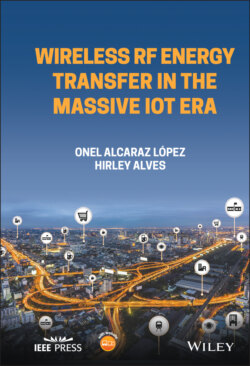Читать книгу Wireless RF Energy Transfer in the Massive IoT Era - Hirley Alves - Страница 20
1.5 Final Remarks and Discussions
ОглавлениеIn this chapter, we discussed the exponential growth of the IoT in the recent years, and its potential to impact complete value chains across many sectors, societal and industrial alike. We highlighted how wireless connectivity is instrumental to these changes. Moreover, we introduced and discussed selected use-cases, requirements and KPIs, key technologies and enablers for building sustainable ICT. Before concluding, let us discuss further a fundamental issue in massive IoT, and how it is addressed in this book.
The ‘Power Problem’ in Massive IoT. The energy use and demands of a MTD may be small, in the order of μW to mW. Nonetheless, powering a large number of devices in the network poses a herculean task. Even though most of the devices are battery-powered and current connectivity technologies promise more than ten years of battery life, a MTD performs much more tasks than communication. Hence, its battery, and therefore the device’s lifetime, may run out sooner than anticipated. Thus, the battery needs replacement, and in some cases discarding the whole device. In any case, the generation of electronic waste (e-waste) becomes a serious issue since it posses a health and environmental hazard due to toxic additives or hazardous substances [81, 82].
The UN monitors the generation of e-waste closely. Its recent report [82] indicates a record of more than 53 million tonnes of e-waste in 2020 (21% increase in 5 years), and it predicts more than 74 million tonnes by 2030. Though some initiatives towards recycling are already taking place Spectrum-battery, more actions shall arise in the next decade. Moreover, considering the massive number of devices and shorter life cycle, the volume of person-months for maintenance-related tasks becomes economically unsustainable for many small and larger businesses alike.
All in all, battery-equipped MTDs are not a scalable solution for massive IoT deployments due to frequent replacements that may become dispendious and contribute to the generation of e-waste. In order to tackle this issue, EH (photovoltaic, induction, RF, among others [78, 79] has become a sound solution for powering such a massive number of devices. A recent white paper from a multi-disciplinary expert group indicates WET as a powerful technology for future mMTC [35]. A recent study proposes WET as a critical component toward sustainable ICT.
The RF–EH Solution. In this book, we advocate using RF-based energy transfer and harvesting for massive IoT deployments. We are continuously developing a technology called massive WET6, which from inception targets the power problem in massive deployments of MTDs.
Massive WET techniques [77, 78, 84–88] deployed in a power beacon (PB) allow powering a multitude of devices without imposing communication overhead. Besides, massive WET 1. increases the battery life cycle of MTDs, consequently enhances network lifetime; 2. contributes to the replacement reduction of batteries and devices, thus decreases the generation of e-waste; and 3. facilitates deployment and planning of the network. Due to wireless powering, device placement is flexible and even possible in dangerous or difficult to reach places; and 3) incites development of batteryless devices. WET will be ubiquitously available and devices can rely solely on WET to operate.
We envision a ubiquitous wireless power architecture composed of several PBs, employing the massive WET techniques discussed in this book. This architecture coexists and complements the information network (cellular or unlicensed LPWAN) such that a massive number of IoT devices (MTDs, battery-equipped and batteryless alike) profit from guaranteed energy delivery.
